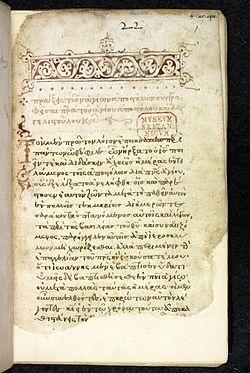- Minuscule 385
-
New Testament manuscripts
papyri • uncials • minuscules • lectionariesMinuscule 385
The first page of the Book of Acts; decorated initial 'T'Text New Testament (except Gospels) † Date 1407 Script Greek Now at British Library Size 21.8 cm by 14.5 cm Type Byzantine text-type Category V Minuscule 385 (in the Gregory-Aland numbering), α 506 (Soden),[1] is a Greek minuscule manuscript of the New Testament, on paper. Dated by a colophon to the year 1407 (May).[2] The manuscript has no complex context. Formerly it was designated by 60a, 63p, and 29r.
Contents
Description
The codex contains the text of the Acts, Pauline epistles, Catholic epistles, and Book of Revelation on 267 paper leaves (21.8 cm by 14.5 cm) with some lacunae (James 1:1-11; Rev 22:2-18.20.21). The text is written in one column per page, in 26 lines per page.[2] The initials and titles in red.
It contains Prolegomena to the Pauline epistles, prolegomena to the Catholic epistles, subscriptions at the end of each book, and numbers of stichoi.[3]
Text
The Greek text of the codex is a representative of the Byzantine text-type. Aland placed it in Category V.[4] In Book of Acts some the Western readings.
In Acts 8:39 instead of πνεῦμα κυρίου (spirit of the Lord) it has unusual textual variant πνεῦμα ἅγιον ἐπέπεσεν ἐπὶ τὸν εὐνοῦχον, ἄγγελος δέ κυρίου ἥρπασεν τὸν Φίλιππον (the Holy Spirit fell on the eunuch, and an angel of the Lord caught up Philip) supported by Codex Alexandrinus and several minuscule manuscripts: 94, 103, 307, 322, 323, 453, 467, 945, 1739, 1765, 1891, 2298, 36a, itp, vg, syrh.[5]
History
The manuscript was written by Georgios Baiophoros, a scribe. It was bound later with Uncial 0121a.
The manuscript was examined by Griesbach (Acts 1-8, 1 Peter, 1 John 5, Romans, 1 Cor, 2 Cor 3, Ephesians, Rev) and Scholz. C. R. Gregory saw it in 1883.[3]
Formerly it was designated by 60a, 63p, and 29r. In 1908 Gregory gave the number 385 to it.[1]
The manuscript is currently housed at the British Library (Harley 5613) in London.[2]
See also
References
- ^ a b Gregory, Caspar René (1908). Die griechischen Handschriften des Neuen Testament. Leipzig: J. C. Hinrichs'sche Buchhandlung. p. 62. http://www.archive.org/stream/diegriechischen00greggoog#page/n73/mode/2up.
- ^ a b c Aland, Kurt; M. Welte, B. Köster, K. Junack (1994). Kurzgefasste Liste der griechischen Handschriften des Neues Testaments. Berlin, New York: Walter de Gruyter. p. 70. ISBN 3110119862.
- ^ a b Gregory, Caspar René (1900). Textkritik des Neuen Testaments. 1. Leipzig: Hinrichs. p. 269. http://www.archive.org/stream/textkritikdesne00greggoog#page/n281/mode/2up.
- ^ Aland, Kurt; Barbara Aland; Erroll F. Rhodes (trans.) (1995). The Text of the New Testament: An Introduction to the Critical Editions and to the Theory and Practice of Modern Textual Criticism. Grand Rapids: William B. Eerdmans Publishing Company. p. 139. ISBN 978-0-8028-4098-1.
- ^ Nestle-Aland, Novum Testamentum Graece, 26th edition, p. 345; Bruce M. Metzger, A Textual Commentary on the Greek New Testament (Deutsche Bibelgesellschaft: Stuttgart 2001), p. 316.
Further reading
- J. J. Griesbach, Symbolae criticae ad supplendas et corrigendas variarum N. T. lectionum collectiones (Halle, 1793), pp. 162-164, 191-212.
- F. H. A. Scrivener, An Exact Transcript of the Codex Augiensis (Cambridge and London, 1859), p. 72.
- Cyril E. Wright, Fontes Harleiani: A Study of the Sources of the Harleian Collection of Manuscripts in the British Museum (London: British Museum, 1972), pp. 115, 459.
External links
- Harley 5613 at the British Library
Categories:- Greek New Testament minuscules
- 15th-century biblical manuscripts
- Harleian Collection
Wikimedia Foundation. 2010.

